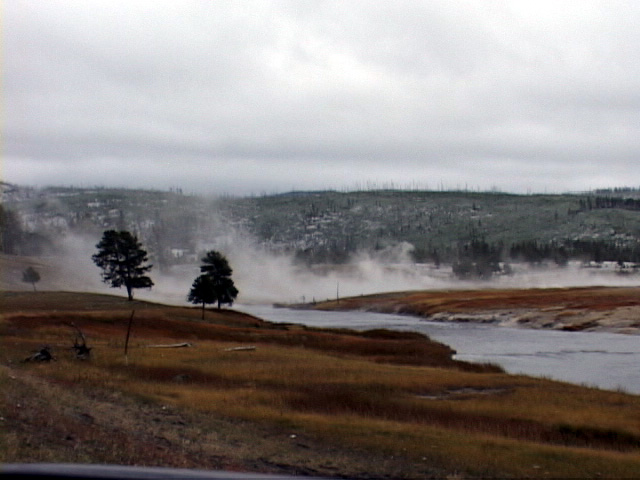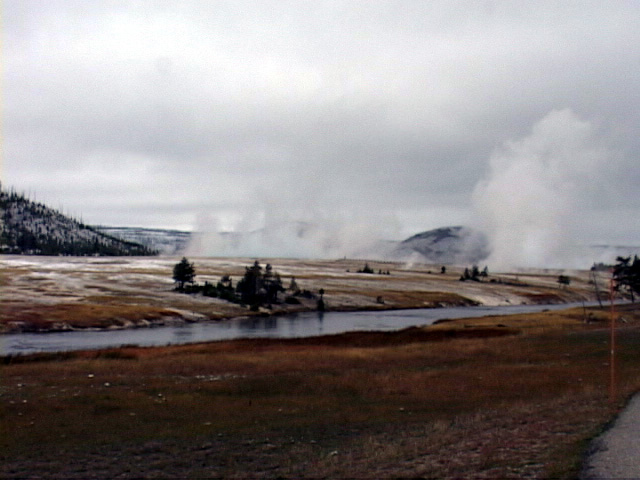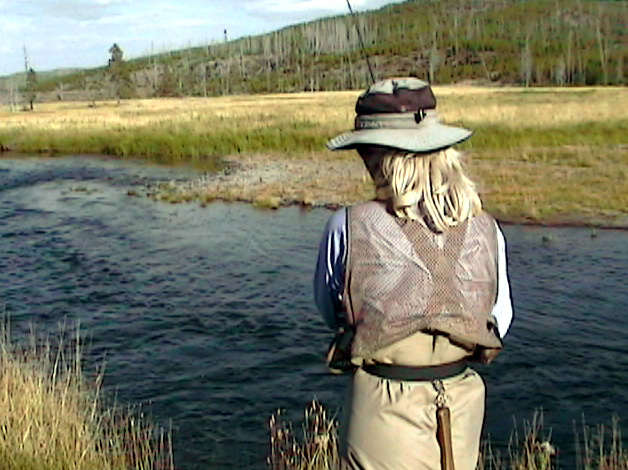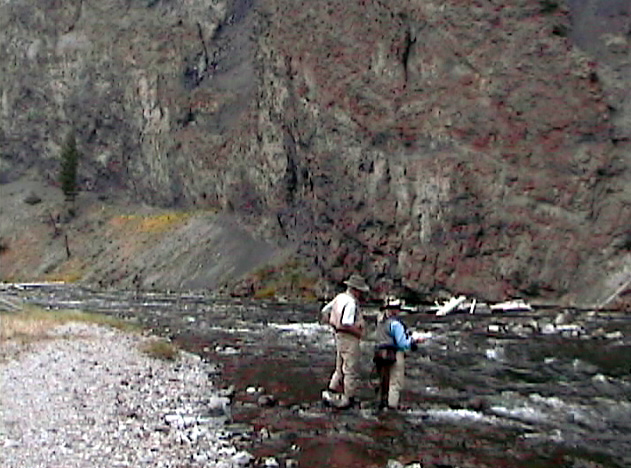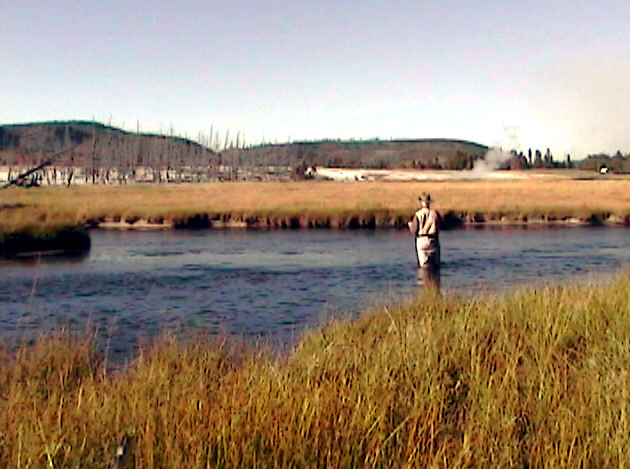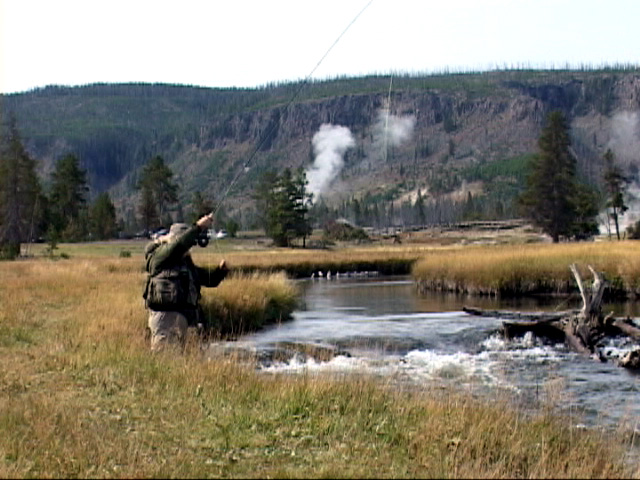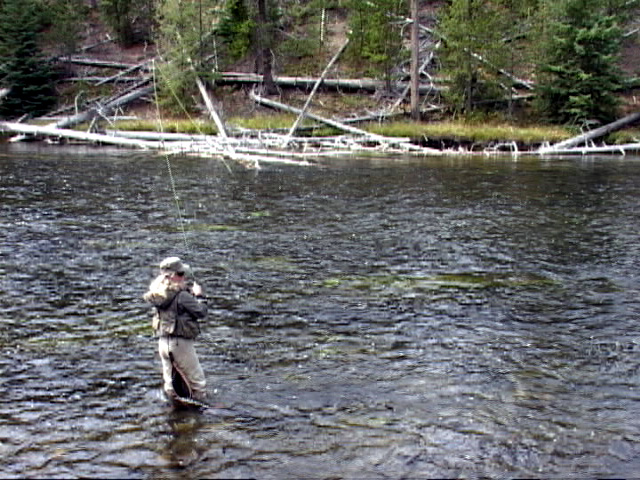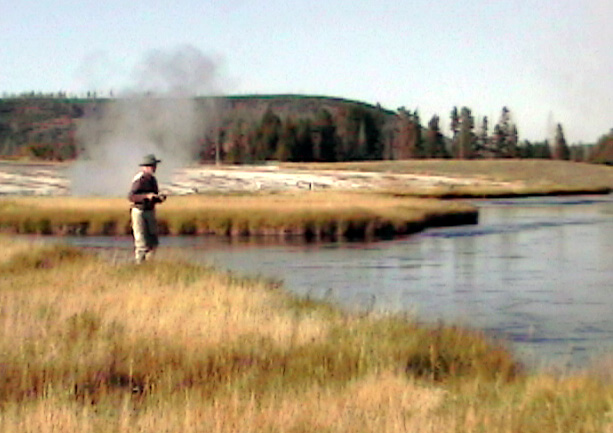
the Firehole River.
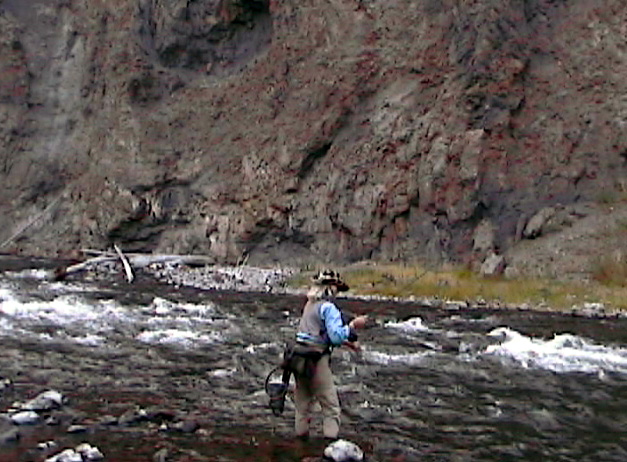
Firehole Canyon. This section of
the stream is entirely different
than any of the other sections.
This is fast pocket water.
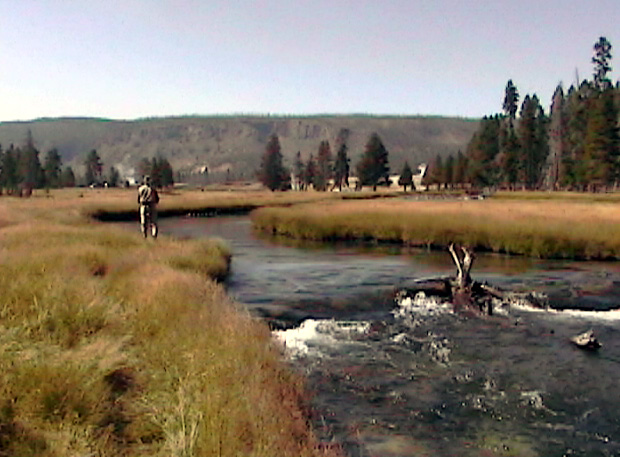
smooth only to suddenly fall into a
section of runs and riffles. Each type
of section fishes differently and
requires different techniques.
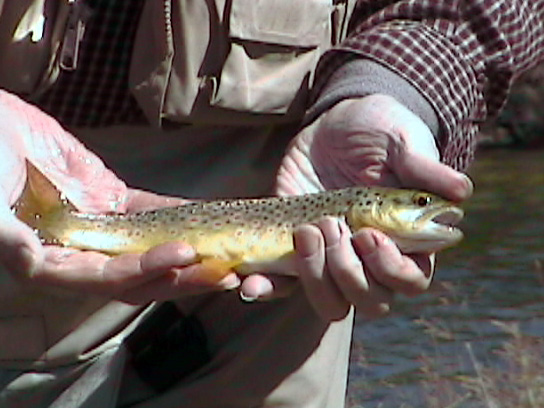
make the Firehole River their home.
The fish are plentiful but are not
necessarily pushovers.
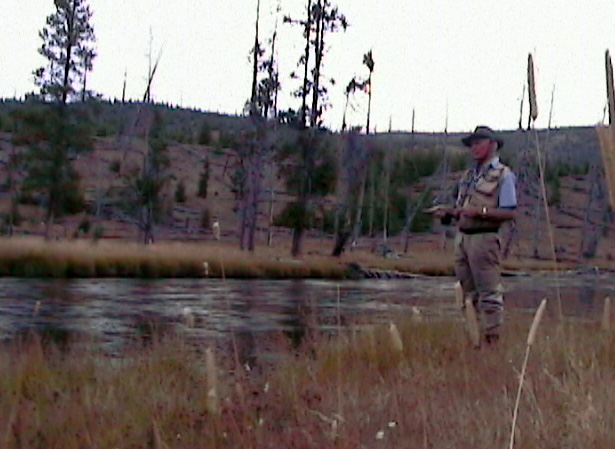
the Firehole. During the summer this
stream helps cool the Firehole
downstream.
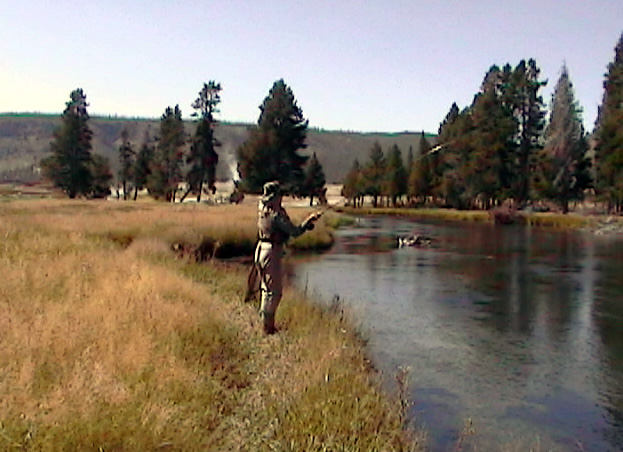
water appears easy to fish. Aquatic
vegetation swirls the water creating
conflicting currents that make it
difficult to get a drag free drift. The
results are that it is more difficult to
fish than one would think off hand
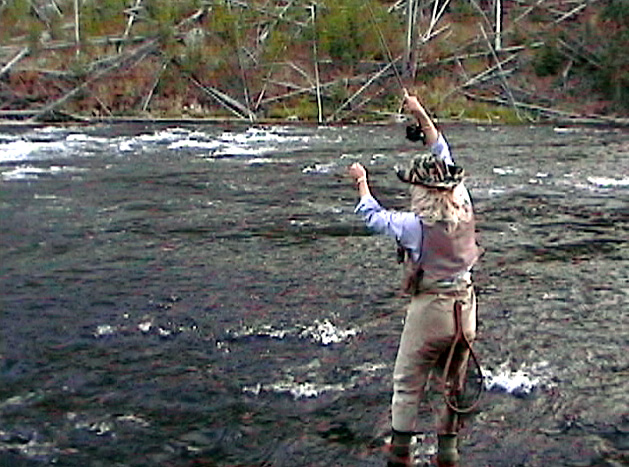
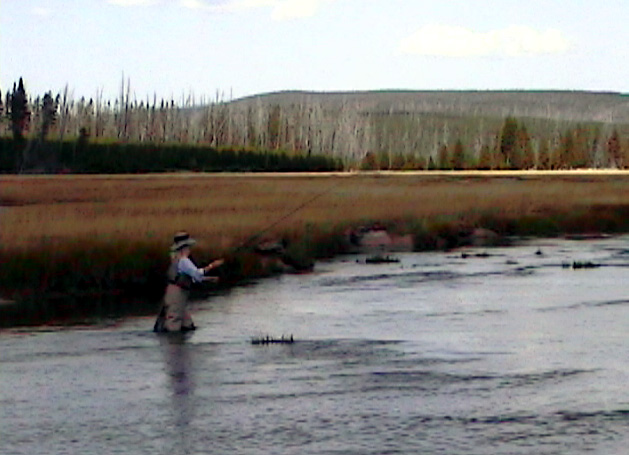
The Firehole River starts in the southwest corner of Yellowstone National Park. It begins at Madison Lake and flows about 30 miles before it empties into the Madison River. Fish the river on an early summer morning and you will probably think that you are dreaming or that you have died and gone to hell while you were on a fly-fishing trip with all the steam rising from the geysers.
Click for Additional Information On the Firehole River
The Firehole River is part freestone stream and part spring creek. The main difference is the springs are adding hot water from geysers. When the season first opens in Yellowstone Park, the warm water helps by bringing the water temperatures up. The Firehole may be the only stream in the park that you can fish during the spring runoff time for many other streams. Soon thereafter, the situation will reverse, and the added warm water from the geyser basins will raise the water temperatures beyond that optimal for trout. It will be sometime in the month of September before water temperatures get back in the preferred range and the fishing action is once again, hot.
The water temperatures in the Firehole River can vary from one place to another. Being at the right place on the river at the right time is the key to fishing the stream. The geyser locations add hot water and the tributaries add cool water and you may need to adjust accordingly.
The Firehole River is the first stream in the park to clear itself of snow and ice and become fishable. It may be the only one you can fish on opening day of the season.
Above Kepler Cascades, the small Firehole River flows through some meadows and a canyon. The river is closed from the Firehole Bridge a mile and a half above Old Faithful to the bridge at Biscuit Basin, about a mile and a half downstream of Old Faithful. This protects the fragile Upper Geyser Basin.
The uppermost portion of the river can be accessed from the Bechler River Trail. Above the Kepler Cascades, the fish are all brook trout. You can access the river below Kepler Cascades from the Firehole Bridge on the Grand Loop Road upstream of Old Faithfull. You can only fish upstream from the bridge to Kepler Cascades.
Below the Biscuit Basin Bridge the Firehole River flows through some large meadows. The stream varies in width and depth flowing through a series of curves. Riffle sections connect the meadow sections of the stream.
The upper half of the 8 mile long section of the river from Sentinel Creek to Biscuit Basin is easily accessed from the nearby Grand Loop Road. The lower half of this section, about 4 miles long, requires a short hike of a mile or so from the road.
Below Sentinel Creek the Firehole River flows through area of alternating meadows with lots of weeds and riffle sections for the first couple of miles downstream. Soon thereafter, there are more riffles than meadows because the gradient of the stream increases all the way to the Firehole Falls. The last couple of miles of the river, below the falls, consist of fast riffles and runs. It flows through a canyon all the way to its confluence with the Gibbons River to form the Madison River.
The trout in the Firehole River are rainbow and brown trout that average from 7 to 12 inches long. Some may go up to 16 inches or better. The last 2 miles of the river, below Firehole Falls, gets some spawning browns from the fall migration of Hebgen Lake trout. Some of these fish may go up to 24 inches long. From Sentinel Creek north to the Madison River, a distance of about 6 miles, the Firehole River is accessible from the Grand Loop Road in its upper 4 mile long section. Below the falls, the river is accessible from Firehole Canyon Drive only in a few places.
Little Firehole River:
The Little Firehole River and the Upper Geyser Basin adds a lot of water to the main river. The Little Firehole starts in a meadow only 4 miles upstream from its confluence with the Firehole. It drops off from the flat meadow section where it begins and flows through a deep canyon for about 2 miles. Mystic Falls is a mile upstream of the Little Firehole Rivers confluence with the main stream. Below the falls, the lower mile long section is a meadow stream with lots of deadfall timber, pockets, undercut banks and pools.
The trout in the lower section below the falls are typical size Firehole River brown and rainbow trout. Keep in mind that fish will move into this stream in the cooler water during the warm summer. Above the falls, cutthroat trout and brook trout between 4 and 10 inches are present. The Little Firehole River is accessible from the Biscuit Basin parking area on the Grand Loop Road.
Iron Spring Creek:
Iron Spring Creek is a tributary of the Little Firehole River that enters the stream only a few hundred yards upstream of the confluence of the Little Firehole and Firehole Rivers. Like the Little Firehole River, this stream also starts on a plateau and cascades down to the Biscuit Basin area. The lower 2 miles of the stream is fishable. It flows through the lower meadows curving around through deadfalls of timber, pools, riffles and small runs. It is also accessible from the Biscuit Basin parking area. The fish are the same fish as the Firehole River trout in this area. Larger fish will move out of the main Firehole River into this stream during the hot summer months and can run up to 16 inches long.
Sentinel Creek:
Sentinel Creek is another tributary steam of the Firehole River. It is a small stream of low gradient with some deeper holes and undercut banks.
During the summer months when the Firehole River is very warm, some trout will move into the stream. These fish are usually 9 to 12 inches with some larger trout. The resident fish of Sentinel Creek, rainbow, brown and brook trout average only 6 to 10 inches long. Fish are present up to the falls with more brook trout in the upper portion than browns or rainbows.
Sentinel Creek is accessible from Fountain Flat Drive off the Grand Loop Road about 6 miles south of Madison Junction.
Comments:
The Firehole River is one of the most unusual and interesting trout streams in the world. It would be a shame for any angler to visit Yellowstone Park and not fish this wonderful stream.
Click for Additional Information On the Firehole River
Click Below for Firehole River Hatch Chart:
Spring
Summer
Fall
Copyright 2011 James Marsh
